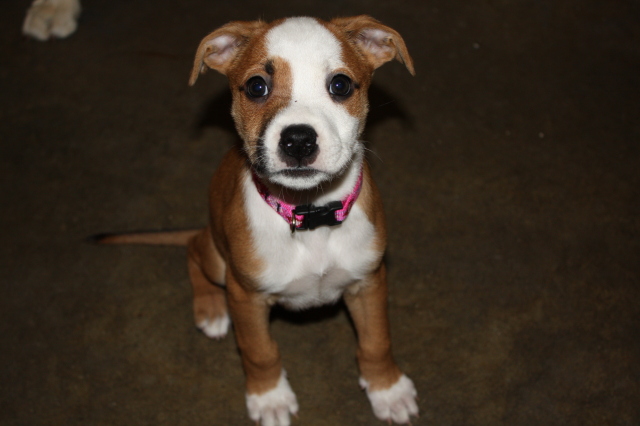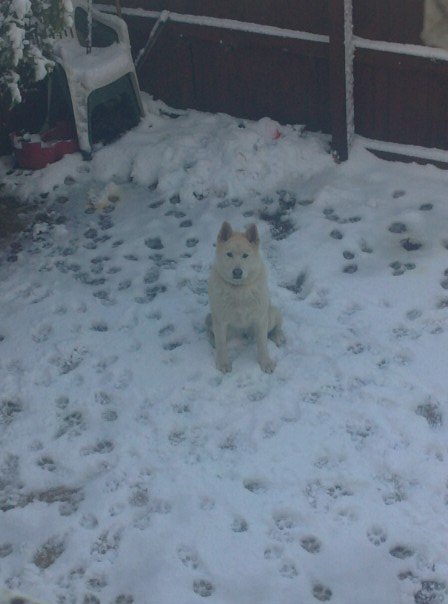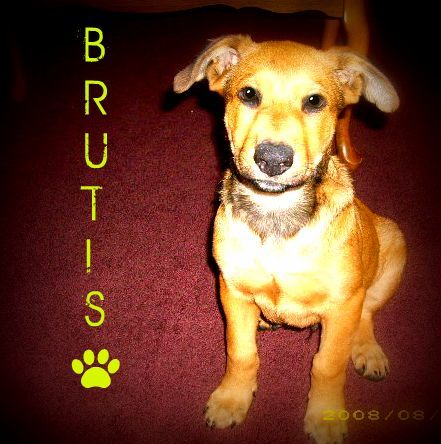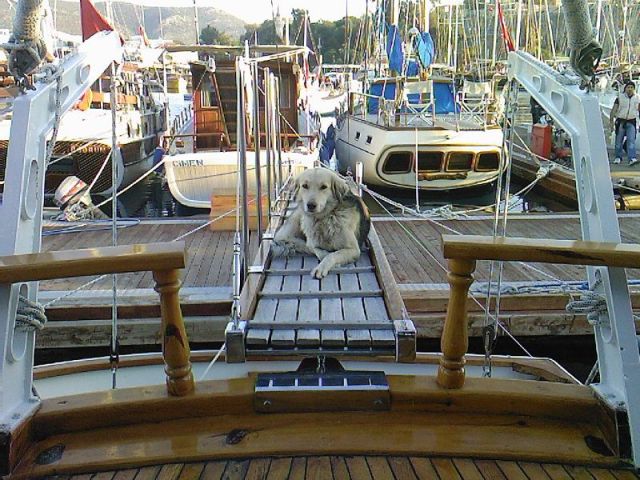QuestionThere has been a small dog running our neighborhood for over 2 weeks, and we finally caught him today.
He appears to be a young (1-2yr)yorkie/pom mix, fixed. Other than fleas and sores from the fleas he is healthy as I can tell. Vet tomorrow. Here is the problem, he is a Houdini, he escaped our fence, and I can not get a collar or leash near him. Due to his breed, I attempted a body harness first and he flipped. Crying, shaking, and withdrawal.
We attempted to slide a collar over his head while petting him, same reaction. While I was sitting here typing this my arm brushed the top of his head while he was sleeping in my lap and he had the same reaction. From all of his body language he appears to be beaten and broken. He does not want to play, he will wag his tail some. We have managed to give him a bath and he has jumped onto the bed and claimed a pillow, but I need to get a way to protect him from himself. He knows how to climb over the fence, we spent an hour following him and offering treats to get him back today.
Any insight on how to get over this fear, would be appreciated.
Thank you,
Donna
AnswerGreetings, and thank you for contacting All Experts,
First of all, I want to thank you wholeheartedly for taking in this poor dog, he sounds like he was in pretty bad shape! I hope he checks out fine for the vet visit. From what it sounds, it looks like he is terrified of having collar and leash on. Since we do not know his history, we should therefore, assume he has never had one on before, or perhaps he did, but it may have been such a negative experience as to cause a reaction as so. So, due to lack of information, I think it would be best to start from scratch and treat him as a total newbie to this.
Because he is a small breed, generally, a harness is the best choice. Collars in small dogs may predispose to a condition known as tracheal collapse, a condition popular in both Yorkies and Poms, however, it is easier to get a dog used to a collar than a harness, simply because a collar is just slipped on around the neck whereas a harness requires you to handle paws and it feels more restraining and therefore gets more steps to get used to. You can read more about tracheal collapse in the following link:
http://alexadry.hubpages.com/hub/Dog-health-Understanding-Collapsed-Trachea-in-D
It is up to you on which one you want to introduce first. While the collar is easier to accept, you may want to switch to a harness later. Or you may start directly with the harness but the process will take longer. I will provide a step-by-step guide on how to introduce both using desensitization and counter-conditioning.
There are unfortunately countless dogs surrendered in shelters that have never seen a collar and leash before. Because often such dogs were neglected and barely taken care of, the owners may have likely failed to care for the animal's training and needs for a walk. Signs a dog may have never worn a collar and leash before are the following:
Shaking, acting anxious in general
Whining, crying
Pawing at the collar
Moving and jumping as a wild horse
Rubbing against surfaces in an attempt to remove the collar
Twisting the head repeatedly and backing off in an attempt to slip out of the collar and running off when successful
When dogs exhibit such strong responses it means they are "flooded". Flooding, also known as exposure therapy, is part of behavior therapy. During flooding, a dog is basically forced to face its fears in hopes to overcome them. There are little guarantees this method works. Just as tossing a child who fears water into a pool, there are chances the child may overcome its fear or that it may worsen. While flooding may yield fast results when it works, it is also more traumatic and less effective. Also, unlike humans who can rationally talk themselves out of a fear, dogs panic until their brain shuts down. There are fortunately more effective methods and we will see two of them below.
Since you noticed this strong emotional response you did the right thing to try to slide the collar while petting him. While this may be helpful in some cases, however it often is not enough to overcome the intense fear. Also consider the fact that you have just met this dog just recently and therefore his level of trust will likely not be sufficient to yield results at this point. So what to do? I mentioned above using desensitization and counter- conditioning. Let's see what these are and how they can be applied to your situation.
Desensitization
Desensitization is a form behavioral therapy that is opposite to flooding. Instead of forcing the dog to face its fears which may be traumatic and overwhelming, the dog is exposed gradually and under the threshold. Therefore, if hold your dog down and slip a collar on he will be way over the threshold causing him to panic, shake and cry, whereas, if you gradually expose your dog to the collar, the emotional response will be less intense.
In desensitization, therefore your dog would be gradually exposed to the collar and the feel of wearing it but in gradual increments without overwhelming him. This process takes quite some time and much care must be taken to work under threshold. You must be able to recognize early warning signs of stress (becoming tense, attempting to escape, dilated pupils, licking lips) so to not ask too much at once. Remember: if the experience your dog is exposed to is too intense, this may lead to "sensitization" which is the opposite of desensitization, therefore, the fear will increase rather than decrease. In your case, therefore, you would have to, at the moment, avoid forcing the collar on him.
Counter-conditioning
While desensitization is a powerful behavior modification program on its own, by adding counter-conditioning on top of it, its power will double. Counterconditioning in layman terms means changing the emotional response. If your dog does not like the collar, he may have been conditioned to act fearfully at its sight. In counterconditioning we are changing your dog's emotional response and attitude towards the collar, flipping it upside down. In other words, we want to change the negative associations and create positive ones. So if collar=fear we want to shift it to collar=rewards! No need to worry, your dog does not have to have a degree in math to understand this equation nor do you need to have a degree in behavioral science! I will provide you with a step-by-step guide that will combine desensitization and counter conditioning for proper collar fitting.
Introducing a Collar For the First Time Step by Step
Items needed:
High-value treats (hot dog, liver treats, pieces of left over steak, commercial treats)
Collar
Food bowl
Toys
1) Place the collar in the middle of the floor and the moment your dog goes to sniff it, say "good" immediately followed by a treat.
2) If your dog is reluctant to go sniff it,make a small trail of treats that lead to the collar with a bonus treat (something your dog loves) in the middle of the collar
3) When you feed your dog always place the collar next to dog bowl. When the food bowl is put away so is the collar. Collar comes out only when there is food.
4) Hold the collar in one hand and food in the other. Keep the collar behind your back. Show it and the moment your dog sniffs the collar, immediately say "good" and give a treat. Put the collar behind once done eating your back and repeat. What we are trying to do here is make it clear that the collar is what brings the treats and once the treat is eaten the collar disappears too. Once your dog gets used to seeing the collar and actually is eager to see it because he has associated it with treats you can progress.
5)Take the unbuckled collar and make it touch his neck for a split second and treat at the same time. Touch the neck and treat, touch the neck and treat. Do this several times until he looks forward to being touched with the collar.
6)Now buckle the collar the largest it can be made but don't put it on him yet! Get a handful of treats in one hand and feed it through the loop. His muzzle should slightly get through the loop. Reward and give treats. Repeat several times trying to get more and more of his head through the loop.
7)Now unbuckle the collar and place it on his neck and continue the touch neck and treat, touch neck and treat. Finally, try to briefly make the two ends of the collar touch while he is busy eating treats. Remove once he is done. Repeat, repeat, repeat.
8)Try again to briefly make the two ends of the collar touch while he is busy eating treats. Remove once he is done. Finally, try to pretend your are buckling it on while he is busy eating treats. Remove once he is done.
9)Try again to pretend you are buckling it on and give treats. This time though buckle it for real but very loose. Give treats and repeat.
10) Now buckle it snug enough that two fingers can be placed in between. Make a big deal of it, tell him how good he looks in it! and give lots of treats. Remove the collar and stop giving treats and no more praise. Just plain boring! Don't remove the collar if he starts to panic (this should not happen though if you followed the steps carefully. Rather, try your best to keep him engaged on treats or a toy and remove it only once he is calm. To make an even stronger association, try to put the collar on before meal time and keep it on during the meal. Remove it once your dog is done eating. With time, the collar will become a cue that food is coming! Just as a bib!
*Note: If at any time, during this exercise your dog appears uncomfortable go back a step and find his comfort zone again and restart from there. Make it clear that great things happen when the collar is on but life gets boring when it is out of sight!
*Note: You also mentioned he is fearful of being touched on the head. Try to slightly touch his head and treat, touch head and treat, repeat, repeat, repeat. Make it a habit to touch is head slightly before meal time. Because he is so sensitive in the head area, avoid slipping the buckled collar directly on, rather try buckling it.
How to Train a Dog to Wear a Leash for The Very First Time
1) Once your dog has accustomed to the feel of the collar on for gradually longer and longer periods of time, you can then start introducing the leash. As soon as you clip the leash on, give a treat, then un-clip it when your dog is done eating. The clipping sound becomes a cue that a treat is coming!
2) Once your dog enjoys having the leash snapped on, snap it before meal time and then unsnap it once he is done eating.
3) Snap the leash on and now call your dog to you with him dragging it and give a treat. Unclip the leash.
4) Snap the leash on and hold it, walk a few steps ahead and call your dog to you, give treats.
Never pull on the leash. Doing so will create negative connotations with its use. If your dog starts pulling coax him near you until the leash is loose and give a treat. You want your dog to learn that staying near you loosens the leash and this is the place to stay.
*Note; if your dog tends to slip out of collars due to conformation (some dogs such as greyhounds or other sight hounds have narrow necks) or learned behavior, invest in a martingale collar.
How to Introduce a Harness for the First Time
As mentioned, with a harness, things get trickier because it takes more steps to introduce and more touching which the dog may not be used to.
1)Introduce the harness in the same way your dog got used to the collar. Place it near the food bowl when your dog eats its meal, give treats for investigating it etc.
2) Get your dog used to having its front paws handled. Touch the paw, treat, lift the paw treat. Do the same with areas the harness will touch.
3) Because this process is easier seen than explained, I will direct you to a video where a dog is clicker trained to accept a harness. You do not have to necessarily have a clicker, you can give instead a positive marker such as "yes"! or 'good'! Here is the video:
http://www.youtube.com/watch?v=k7edMjwEY1c
To learn more about positive and negative markers read here:
http://adrienne-farricelli.suite101.com/the-use-of-cues-markers-and-release-word
As seen, baby steps are the way to go with a dog who has never worn a leash and collar. With time and patience, your dog will hardly notice it is wearing a collar. Leashes will also become very exciting overtime, after you snap them on for treats and meals. Once you start walking your dog, your dog will also associate leash with walks which often leads to much excitement and happy tail wags!
I hope this helps you out, thanks again for opening your heart and home to this dog. Please take a moment to rate my answer, best wishes and kind regards!
Adrienne Farricelli CPDT-KA

 agression
QuestionNew Pup
QUESTION: I am so totally at wit
agression
QuestionNew Pup
QUESTION: I am so totally at wit
 Dog Training And Punishment?
Question
Maya
hi there i have an akita X husky,
Dog Training And Punishment?
Question
Maya
hi there i have an akita X husky,
 dog training.
Question
Brutis
I have a 6 month old german shepherd/la
dog training.
Question
Brutis
I have a 6 month old german shepherd/la
 breed identification
QuestionMaggie
QUESTION: Hello - Ive hopped over
breed identification
QuestionMaggie
QUESTION: Hello - Ive hopped over
 Dog jumps on counters, Refrigerator,cabinet tops when Im not home
Question
Bell
Hello,
I dont even know where to
Dog jumps on counters, Refrigerator,cabinet tops when Im not home
Question
Bell
Hello,
I dont even know where to